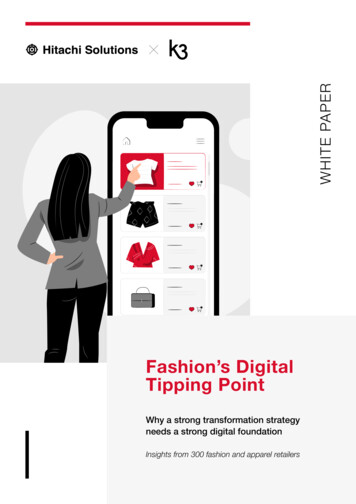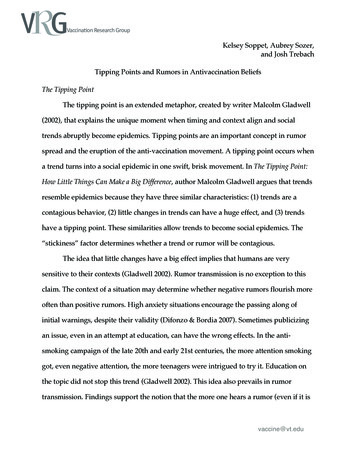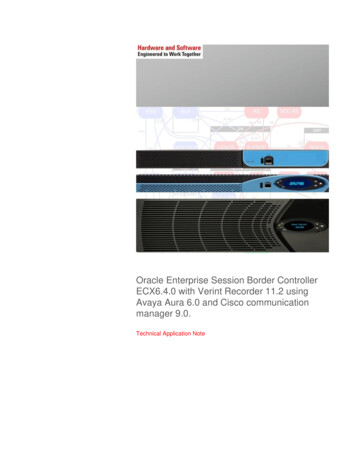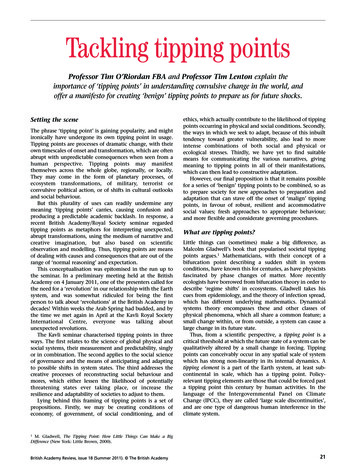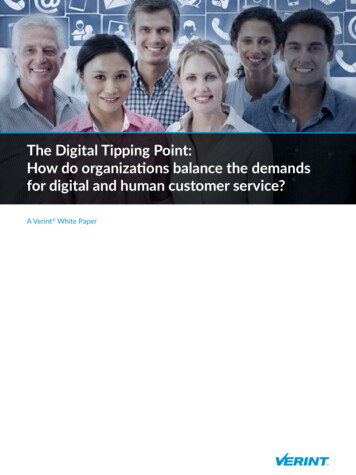
Transcription
The Digital Tipping Point:How do organizations balance the demandsfor digital and human customer service?A Verint White Paper
White Paper – The Digital Tipping PointTable of ContentsForeword. 1Executive Summary.2Key Findings. 2Defining Generations.21. Understanding the Tipping Point.32. What is Influencing the Tipping Point?.63. The Influence on Customer Behavior.94. Six Steps to Improve the Customer Journey in an Increasingly Digital World. 12Conclusion. 14
White Paper – The Digital Tipping PointForewordIt is both exciting and unnerving to participate in today’s business climate – a climate marked by – changingcustomers, rapidly evolving technology and business model disruptions. The disruption is on course to continuebringing far reaching changes with a broad ripple effect on an organization’s most valuable asset – its customers.The effect of these changes are being felt at the point of consumption – by the end customer. In the race todifferentiate, enhance go-to-market strategy and at times reduce cost, technologies such as FAQ, Web portals,and real-time video have all found their way into the customer interaction environment. But what is the ultimateimpact and how can brands prevail in a highly competitive environment while satisfying their customers?The survey results discussed in this paper are extremely valuable for organizations wrestling with the issue ofdigital versus traditional service options. This is not an era of polarization. Of voice versus digital or live supportversus self-service. These options actually represent a symbiotic relationship; understanding the subtletyinvolved will yield the right solution for the organization and its customers.Organizations now have the opportunity to re-evaluate how they can interact with their customers in a mutuallybeneficial way. The IDC definition for customer experience takes a comprehensive view where:Customer experience involves the alignment of the corporate goals of the organization to create an experience(including the product/service) for the customer to meet the expectations of that customer in engagements thatresult in satisfaction. It includes the orchestration of internal business processes to create a flow that is plannedand architected in a manner that makes the interaction from the customer’s side as easy, quick, transparent,positive, and as full featured as possible through any customer journey and over the life time of that relationship.The two concepts that are of particular importance are that there are individual journeys and that this is arelationship that can span multiple interactions over a period of time. The survey results shed light on thisphenomenon where the respondents identified different channel preferences for certain customer inquiries.There are different requirements for different interaction types, stage of the customer journey, complexity of theinquiry and customer preferences.Ultimately, all channels need to be present. It will not be a landslide to digital or back to voice but a waterfalleffect. Just like television didn’t eliminate the need for radio, so too, digital will not eliminate the need for agents.The opportunity is at hand for leaders to consider the culture of customer engagement, how they will executeon it and what it means to their competitive differentiation. As the survey results indicate, there is a need tolook past the top line results of preference for the voice channel and ask ‘why?’ What is deficient in the currentofferings and how can an organization bridge to the customer’s expectations?Mary Wardley, Vice President, Enterprise Applications and CRM Software, IDCVerint. Powering Actionable Intelligence.Verint Systems Inc. (NASDAQ: VRNT) is a global leader in Actionable Intelligence solutions for customerengagement optimization, security intelligence, fraud, risk and compliance. Today, more than 10,000 organizationsin over 180 countries use Verint solutions to improve enterprise performance and make the world a safer place.Learn more at www.verint.com.Page 1
White Paper – The Digital Tipping PointExecutive SummaryDigital disruption is changing business. The rise of smartphones and the mobile web has helped organizationsreach customers and audience segments they never thought possible. Yet, while digital services may havecreated new opportunities for organizations, it is not without its challenges.Verint’s survey and white paper “Customer Centricity – The Rules of Engagement” last year showed there isa disconnect between customers who want highly personalized service and those who just want the basicsdone well. Today, many customers now consider digital elements, such as an email address or a website, a basicservice. But this doesn’t mean there isn’t room for improvement when it comes to digital customer service andpersonal interactions.The organizations that embrace digital may be on the pathway to success, but those who do so at the expenseof traditional customer service risk falling behind. So how do brands know how, when and what to invest inwhen it comes to digital and traditional channels? And when do they need to tip the balance in favor of oneor the other?This paper seeks to answer the question: how do businesses get the balance right between digital and humancustomer service? To do this, more than 24,000 respondents across 12 countries were questioned by OpiniumResearch LLP, a UK-based research agency. Verint additionally polled more than 1,000 businesses as part of the study.Key FindingsWhile cost is certainly an incentive for brands looking to adopt digital methods and automate elements of theircustomer service, it may come at a price. Organizations that rely too much on digital channels risk missing out onongoing and meaningful relationships with customers. Overall, our research highlights that: Consumers want a human element to remain part of customer service. Those who receive more “human” or traditional customer service display more positive behaviorstoward brands. The complexity of the request heavily influences whether a customer will choose a digital or traditionalchannel. Organizations are aware of the importance of the human touch in customer service, yet most businessleaders are planning to implement more digital service options. The younger generations are driving demand for digital channels, but for digital customer service to reallysucceed, it needs to provide a more human experience.Defining GenerationsThis white paper explores the differences in responses between age groups. For the purposes of this paper,Millennials (also commonly referred to as Generation Y) are aged between 18-35, Generation X is aged between36-50, Baby Boomers are aged between 51-70 and the Silent Generation is anyone aged over 70.Page 2
White Paper – The Digital Tipping Point1. Understanding the Tipping PointWhat Customers WantWith the rise of digital communications tools andsocial media, there has been a natural demand forcustomers to be able to communicate with brandsvia multiple channels. Now, they consider emailand brand websites as basic-level service channels.However, when given the choice of how they wouldlike to interact with organizations, picking up thephone (24 percent) or going in store (23 percent)are the most popular options. Consumers like to begiven the ability to manage their accounts online (22percent), while email is the next most popular digitalchannel with 14 percent.When asked which communication channelconsumers would prefer brands to offer, the mostcommon responses are in store (15 percent), onlineaccount management (15 percent) and speakingon the phone (14 percent) – a clear indicator thatcustomers want an element of human interactionto remain part of the customer service experience.Consumers in the UK and US again champion theuse of online account management platforms, with20 percent of respondents in both countries wantingorganizations to add more of these tools. Onlineaccount management is the most common request oforganizations in India too, with 22 percent. Demandfor mobile apps is highest in Mexico (19 percent) andSouth Africa (18 percent). On the whole, people aregetting used to the idea of live chat (10 percent) andmobile apps (11 percent), while demand for otherdigitally driven tools is much lower, with six percentof consumers wanting brands to offer video chat andfive percent wanting social media channels to engagewith brands.The communications channels that are generatingbuzz, such as Facebook, Twitter or mobile apps, donot perform so well when it comes to customercontact. Only three percent of consumers say theyprefer to contact organizations via social media andnine percent via mobile apps. Looking across regions,consumers in the UK and US prefer to contact theirservice providers via online account managementtools (34 percent and 38 percent respectively), whileFrench, German and Japanese consumers prefer to gointo a store or branch (36 percent, 42 percent and 22percent respectively).How This Differs Based on WhatOrganizations Plan to Implement inthe FutureLooking across verticals at preferred channels, onlineaccount management platforms are most popular withbanks and credit card providers – not surprising giventhe maturity of online banking. Using the phone,however, is most popular for insurance providers,home telephone, broadband and cable operators, aswell as utility companies, such as electricity, gas andwater.When we asked businesses what channels theyare planning to invest in, live chat (32 percent) andmobile apps (27 percent) score highest. And incontrast to consumers’ preferred options, businessesreported they are investing least in traditionalchannels – that is in branch and telephone contact –demonstrating a desire to lead customers to a digitalexperience.Page 3
White Paper – The Digital Tipping PointFigure 1: Consumers’ preferred communications channel compared with what businesses are planningto offer35%30%25%20%15%10%5%0%MySpeak to Speak tosomeone someone accountonlinein personon thephoneEmail/SMSSocialMediaConsumer preferred channelEmphasising that brands must continue to investin more interpersonal channels, such as the phoneor in store, almost three quarters (74 percent) ofrespondents say they don’t like dealing with companiesthat don’t provide a phone number for them tocontact. This rises to 83 percent in South Africa and79 percent in France. However, the figure is as low as64 percent in Germany. There is also a healthy dose ofscepticism towards some digital channels with almosthalf (49 percent) of consumers worldwide admittingthat they think their inquiry is likely to get lost orignored when they contact a provider over email.Clearly customers prefer a human element withincustomer service. The question is why?Globally, approximately two thirds of consumerssay it is because they are more likely to negotiatea better deal, and receive good service generally,when engaging with a service provider in person.1LiveChatWeb el organizations are planning to offerMeanwhile, businesses appear to be overestimatingtheir customers’ preference for digital channels. Incontrast, just over half (56 percent) of businessesbelieve customers get better customer service whenspeaking to someone in person, either in store or onthe phone. In addition, seven in ten businesses thinkcustomers prefer to use mobile apps, email or SMSbecause it allows the customer to contact them “onthe move,” compared to just 44 percent of consumerswho said this.It’s hard to argue with the popularity of digital toolsand social media, given that Facebook has more than1.7 billion monthly active users1. If these tools are sopopular to communicate with friends and family, whydo we still prefer a human element in customer servicesituations?It all comes down to complexity.Wikipedia (2016), Facebook, accessed: https://en.wikipedia.org/wiki/FacebookPage 4
White Paper – The Digital Tipping PointMan vs. Machine?Interacting with a brand or service provider can becomplicated, and it requires empathy, emotionalintelligence and an ability to process information witha broad set of parameters. When we take into accountthe complexity of a request, we start to see morescenarios where digital customer service becomesthe preference.When asked how they would interact with theirservice providers in a fairly simple customer servicerequest, 64 percent of consumers will choose digitalchannels. While the phone is the most popular option(22 percent), email comes a close second (19 percent),while online account management (13 percent) andweb self-service (12 percent) round out the mostpopular channels for simple requests. As the requestsbecome more complicated, the reliance on humaninteraction becomes even greater. For fairly complexinquiries, 60 percent of consumers will choose humaninteraction. Phone is the most popular (36 percent),while going in store ranks second (24 percent), stillway ahead of the leading digital channel – email –with 10 percent.When the request is considered complicated, morethan two third (67 percent) of consumers preferhuman customer service. More than a third(34 percent) go in store, while the phone comes next(33 percent). The nearest digital channel is emailat seven percent. However, when we look at veryspecific customer service situations, we start tosee digital tools become more prominent, and therelationship between complexity and dependence onhuman interaction becomes clearer.Figure 2: Consumers’ channel preferences based on certain customer service situations24%22% 22%18%13%An answer to a simplequestion/ requestTo investigateproducts/servicesTo close myaccountTo change myaccount details17%13%To give positivefeedback43%34%15%20%15%14%29%15%20% 21% 20%24%12%To ask a questionabout my bill19%18%21%8%To register acomplaintUrgent technicalassistance45%23%30%28%21%21%10%1st preference14%2nd preference3rd preferenceAn emergencyserviceSpeak to someone in personMy product/service fixedSpeak to someone on the phoneMy bill refundedMy account onlineEmail/SMSLive ChatWeb self servicePage 5
White Paper – The Digital Tipping Point2. What is Influencing the Tipping Point?Rise, Digital NativesWith more than 3 billion internet users and 1.5 billionsmartphone users worldwide2, digital communicationsrepresent a valuable gateway for brands to reach newcustomers. But clearly, customers prefer to engage withbrands in person, such as the phone and in store. Sowho is actually driving demand for digital tools? Is it acase of customers looking to engage on new channels,or is it organizations trying to move customers on tonew channels in a bid to save costs? Actually, it’s both.The research shows that, perhaps unsurprisingly,younger people are the driving force behind the shifttowards digital communications channels. While onaverage, the most popular first preference acrossgenerations is to pick up the phone or to go in store,digital channels rank much higher in second andthird preference for Millennials and Generation X, asillustrated by the graph below.Figure 3: Preferred Channel by 14%XMillennials15%13%23%24%14%15%In b self-serviceMobile app21%35%2%Social media9%24%9%Don’t know/otherThe same trend can be applied to channels they want brands to offer. Millennials want more digital tools such asmobile apps and online account management tools, while Baby Boomers and the Silent Generation prefer morephone and in store services.Figure 4: Service Channel Wanted Across %14%In storeEmail14%Generation 15%X12%12%12% 11%Live chatWeb tion 16%10%1%8%7% 4%5% 9% 5%2%Mobile appSocial mediaDon’t know/otherWorldwide Smartphone Forecast, 2016–2020: https://www.idc.com/getdoc.jsp?containerId US41084216Page 6
White Paper – The Digital Tipping PointLooking at customer service situations, 30 percent ofBaby Boomers and 37 percent of the Silent Generationwill pick up the phone when they are looking for ananswer to a simple question or request. In fact,17 percent of Baby Boomers and 20 percent of theSilent Generation will go and speak to a person instore or a branch for the answer to a simple question.For Millennials, the most popular option whenaddressing a simple request is to either phone(18 percent) or send an email (17 percent) to theirservice provider. Generation X also prefers the phone(23 percent) and email (17 percent). Similar trendsare found when investigating new products, BabyBoomers and the Silent Generation are happy to pickup the phone or go in store, while Millennials andGeneration X prefer web self-service.There is more convergence between the generationsas customer service requests become more detailed orintensive. For example, when closing an account themost popular choices across generations are email andthe phone. Similarly, when it comes to giving feedback,email and phone are the most popular channels acrossgenerations. However, Millennials are far more likely touse social media to give feedback (10 percent), whileBaby Boomers (16 percent) and the Silent Generation(24 percent) will still go in store. When it comes toasking questions about a bill, seeking a refund orurgent technical assistance, picking up the phone isthe clear preferred channel across all generations, asillustrated in the table below.Figure 5: Channel preferences of generations, averaged across customer service situations40%35%30%25%20%15%10%5%0%Speak tosomeonein personSpeak tosomeoneon thephoneMyaccountonlineMillennialsEmail /SMSGeneration XSocialmediaLive chatBaby BoomersWeb selfserviceVideochatMobileappOtherSilent GenerationPage 7
White Paper – The Digital Tipping PointWhat’s Holding the DigitalExperience Back?Given that Millennials are the long-term customersof the future, it makes sense that digital channelsare implemented to appeal to them. However, ourresearch shows that not everyone is ready to embracedigital. Nearly two thirds (64 percent) of all consumerspolled say they believe that it is more convenientand they get better service when engaging withorganizations on the phone or in a store. Additionally,68 percent of consumers are likely to negotiate abetter deal when they engage with a service providerover the phone or in store. This rises to 78 percentin Mexico and 74 percent in France, while only 51percent of Germans agree.The overall experience needs to improve before morecustomers will fully participate on the digital journeywith organizations. When asked, 67 percent believethat customer service online and via mobile devicesshould be “faster, more intuitive and better able” toserve their needs. Meanwhile, only 44 percent ofconsumers say that digital and self-service customerservice options provide a better overall experience.This is as low as 25 percent in Japan. In contrast, 75percent of Indian consumers believe digital and selfservice channels provide a better overall experience.Businesses acknowledge they need to work harderin this regard too, a significant 91 percent oforganizations surveyed in our B2B survey said thatcustomer service online and via mobile devicesneeds to be faster, more intuitive and better servecustomer needs.Convenience has been touted as one of the greatestdrivers of the digital revolution, allowing people tocontact organizations whenever they want – in thecomfort of their own home or on the move. Thepopularity of internet banking and mobile bankingapps is testament to this.However, the research shows that, given thatthe digital customer service experience needsimprovement, customers’ expectations have changed.Less than half (44 percent) use email, SMS or mobileapps, so they can contact organizations wheneverthey want or while on the go. Similarly, 56 percent ofconsumers like the option of using virtual assistantsand online chat because they get faster resolutions totheir queries. Perhaps one of the major barriers that isholding back the digital customer service experienceis the issue of authentication, albeit advancements infingerprint authentication and voice biometrics arehelping improve this. More than six in 10 (62 percent)wish password and authentication processes could beeasier and faster.A Resounding Call for a HumanElement to RemainWhen asked about the future of customer service, theresults are clear. The vast majority (83 percent) believethat speaking to a customer service representative onthe phone or in store will always be important. Thisis because, ultimately, humans are able to processmany pieces of information at once. They are able tomanage requests with broad parameters, while pickingup on non-verbal cues and displaying empathy andemotional intelligence.Page 8
White Paper – The Digital Tipping Point3. The Influence on Customer BehaviorThe Human Touch Positive EffectsAs we explored last year in “Customer Centricity –The Rules of Engagement”, there is a close relationshipbetween providing a good customer experience andyour customers displaying positive and valuablebehaviors towards your brand. These behaviors includerepeat business, signing up for loyalty programs, andpublicizing positive reviews and recommendationsabout an organization.Looking at customer retention across all sectorssurveyed, more than half (53 percent) of consumershave been with their service providers for more thanthree years, while 11 percent have been with theirproviders for less than a year. This is a decline innumbers from last year’s study, which found that 61percent of consumers had been with services providersfor more than three years and seven percent for lessthan a year. Looking at verticals, banks maintain thehighest customer retention, with 73 percent stayingwith their bank for more than three years, a 9.5 percentdecline from 2015. Meanwhile, eight percent reportthey have been with their bank for less than a year, a100 percent increase from 2015 – indicating switchingis on the rise. In fact, this is true across all sectors.Figure 6: Customer retention figures, across all vertical obilephoneHometelephone,broadband,cableMore than three years (2016)BankCredit cardMore than three years (2015)UtilitiesBrick andMortarRetailerLess than a year (2016)OnlineretailerTravelLess than a year (2015)Page 9
White Paper – The Digital Tipping PointBut what influence do digital or more human channelshave on customer behaviors? Retention is one factorthat could indicate loyalty, but there are severalother important actions that organizations want theircustomers to perform in the journey to building ongoingrelationships. The research reveals there is a discernibledifference in terms of positive customer behaviorsbetween digital and human customer service channels.People are far more likely to respond positively towardsa brand after engaging on the phone or in store. Thismay not seem all that surprising, as few people feelcompelled to thank a computer for doing somethingfor them. Nonetheless, when a customer serviceagent goes the extra mile to help, consumers aremuch more likely to express some gratitude.When consumers have a good customer serviceexperience on the phone or in store, they are morelikely to behave positively towards a brand, than whenonline. They are: 38 percent more likely to renew their product orservice, even if it isn’t the cheapest option 27 percent more likely to sign up to anorganization’s loyalty program 19 percent more likely to leave a positive reviewFurthermore, consumers are 57 percent more likelyto do nothing following a positive customer experienceon digital channels than in person.While it’s a given that the human touch has positiveeffects, it doesn’t stop there. Customer expectationshave increased. For example, four in five customers nowwant services personalized to them and their interests.This creates a challenge for many organizationsbecause, in order to provide a highly personalizedoffering, they need to have a greater understandingof their customers’ needs, histories and preferences.By collecting, analyzing and acting upon the datagathered from customer and employee interactions,organizations are better equipped to do this. However,it is clear that customers are concerned about the useof this data and their privacy. Almost nine out of 10consumers (89 percent) want to know how secure theirpersonal information is, while 86 percent want to knowwhether their data will be passed on to third partiesfor marketing purposes. This is as high as 98 percent inSouth Africa and 96 percent in Mexico, while Japaneseconsumers are least concerned, with 70 percent.Businesses seem to understand the roles that trustand transparency play in building positive relationshipswith customers. A substantial 94 percent of businessespolled agree that it is important to inform customersthat their data is being kept secure, and 96 percentsay they understand the need to tell customersif their data will be passed on to third parties formarketing purposes. They need to help ensure thesehigh standards are maintained, as one misstep with acustomer’s data can have disastrous effects.Page 10
White Paper – The Digital Tipping PointLooking Closer at Digital NativesThese results may sound alarm bells for organizationsthat have invested heavily in digital channels in order toreduce costs or to appeal to new customer segments.However, if we take a closer look at those that are moredisposed towards digital customer service, the resultsstart to look a little different.3When they have a good experience, this “digital native”customer segment is, in fact, more engaged wheninteracting on a brand’s digital channels than thoseconsumers interacting with a human. After a positivecustomer experience online, the digital natives are50 percent more likely to “talk” positively on socialmedia, 29 percent more likely to sign on to a loyaltyprogram, 12 percent more likely to leave a review andfive percent more likely to renew their productor service even if it’s not the cheapest option.Similarly, the digital natives are more aware of theexchange of data that takes place in order to receivepersonalized service. When asked about wanting to3know if their data will be passed on to third parties,84 percent responded “yes,” compared to the globalaverage of 86. Meanwhile, 87 percent of digital nativeswant to know how secure their personal information is,compared with the global average of 89 percent.On the whole, digital natives are also more contentwith a brand’s efforts to engage with them online.Two thirds (66 percent) believe digital channels, suchas self-service and online chat, provide a better overallcustomer experience, compared with the global averageof 45 percent. While it is not surprising that digitallyengaged people are going to have a better view of thecurrent customer experience, organizations can takesome comfort in the fact that their digital channels areappreciated. This will become even more significantas the spending power of Millennials and the nextgeneration grows, the customer preference for digitalchannels as means to engage with brands will becomeeven more popular.For the purposes of this study, Verint grouped together customers whose first preference was to use a digital channel to engage with an organization if they have a simple,fairly complex or complicated enquiry, to create a clear picture of how these digitally disposed customers behave. This group has been labelled digital natives for the purposeof this study.Page 11
White Paper – The Digital Tipping Point4. Six Steps to Improve the Customer Journey in an Increasingly Digital WorldWhile there clearly are noticeable differences betweendigital channels and customer behavior, there isan appetite for digital service among customers.The human touch is likely to remain paramount inthe short term, however, organizations need to actnow to get their digital infrastructure in place sothat the online experience meets their customers’expectations. While investment sounds challenging,there is an incentive for brands to do so as digitalchannels represent a cost-effective way to automatecustomer service and/or provide customers with theability to manage requests themselves. This representsa huge opportunity for organizations to reduce costsif they can successfully offer a digital service that allcustomers embrace. For example, digital customerservice can help to reduce reliance on labor-intensiveelements of service, and even eliminate the need forbranches or shopfronts which are expensive to buildand maintain.How can organizations successfully manage their customers’ journey?1. Listen to your customers – place the voice of the customer at the heart of everything you do.Companies need to understand which channels their customer groups prefer to use and at whichpoint of the customer journey they wish to use them. By putting a v
White Paper - The Digital Tipping Point Executive Summary Digital disruption is changing business. The rise of smartphones and the mobile web has helped organizations reach customers and audience segments they never thought possible. Yet, while digital services may have created new opportunities for organizations, it is not without its .



